|
Visiting
New Zealand's
wine regions
Part 17: Pyramid Valley Vineyards
Website: www.pyramidvalley.co.nz
Mike & Claudia Weersing, 548 Pyramid Valley Road, RD Waikari
7491, North Canterbury, New Zealand
Phone: +64 (0) 3 314 2006
Fax: +64 (0) 3 314 2060
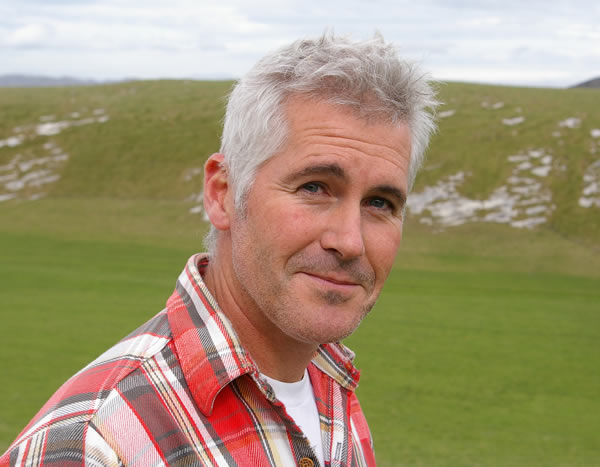
Mike Weersing of Pyramid Valley
It was mid-afternoon when I
left Daniel Schuster Wines to head into the Canterbury hills in
search of a producer who had been recommended to me by James
Millton – Pyramid Valley Vineyards. It was to be one of the most
remarkable and enjoyable visits I’ve yet made as a wine writer,
and I’ve been fortunate enough to have some really good ones in
my short career.
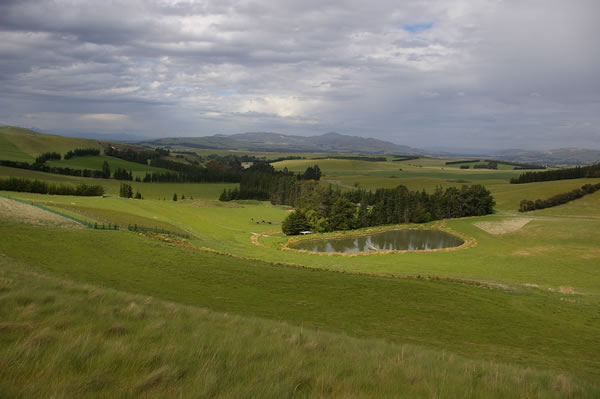
PVV is in the middle of
nowhere, stuck in an expanse of farmland spread across rolling
hills. I arrived to be greeted by Mike and Claudia Weersing. We
got chatting, and before long they invited me to stay the night
– which was hugely kind of them, because I didn’t have
anything sorted. They also phoned my next appointment, Marcel
Giesen at nearby Bell Hill, to rearrange it for the following
morning.
Then I headed off with Mike
to look at the vineyards.
The video I shot is below, and it includes Mike's comments on the
special site they are farming.
First, some background. Mike
and Claudia are from the USA, and Mike – an articulate,
thoughtful and highly educated dude, studied art history and
literature, and left his home town in the California redwoods to
head for the bright lights of Manhattan. There, he worked in art
history and publishing, but this turned out not to be his
vocation. ‘I love literature, but not the business’, says
Mike. ‘I love art, but I’m not and artist, and I love music,
but I don’t like the music business’.
He
followed a girl he loved to Georgia, and she graduated from
veterinary school there. Mike loved living in rural Georgia. 'My
brief time in Manhattan taught me that I wasn't cut out to be a
city boy', he recalls.It was when he spent time
with Josh Jensen at Calera in California, that Mike realized wine
was actually quite interesting.
‘I liked the idea of
working outside, with seasons, not a 9-5 job’, he says. He began
a journey that was to lead him to New Zealand. It was Pinot that
most excited him, and he did a harvest in Oregon with Evesham
Wood. Mike then studied oenology and viticulture in Burgundy, and
then built up a remarkable CV, working for a star-studded cast of
producers (including de Montille, Potel, Pousse d’Or,
Kreydenweiss, Deiss and Loosen).
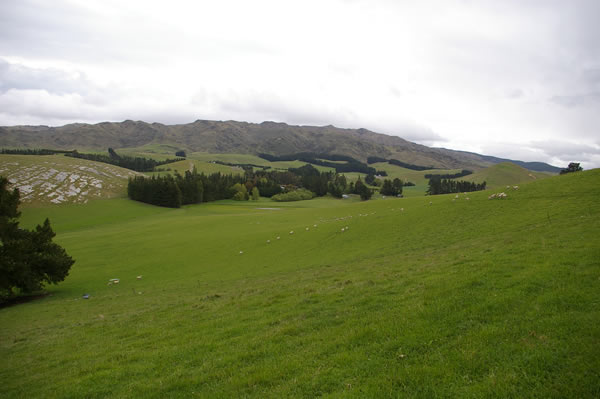
In 1996 Mike and Claudia moved to New Zealand, where
Mike worked as a winemaker with Neudorf in Nelson, but their
desire was to begin a project of their own. For a couple of
seasons, they spent every weekend in winter and spring prospecting
for the right vineyard for growing world class Pinot Noir. Mike
had a specific idea in his head of what the perfect terroir would
look like: clay with limestone, with a marginal climate that was
more continental than the average New Zealand wine growing region.
This is important, because the vine has to make a vegetative to
reproductive shift at the right time in the season. Continued
vegetative growth results in a big leaf area that keeps on pumping
sugar into the developing grapes late on, resulting in a harvest
with a high brix level at maturity.
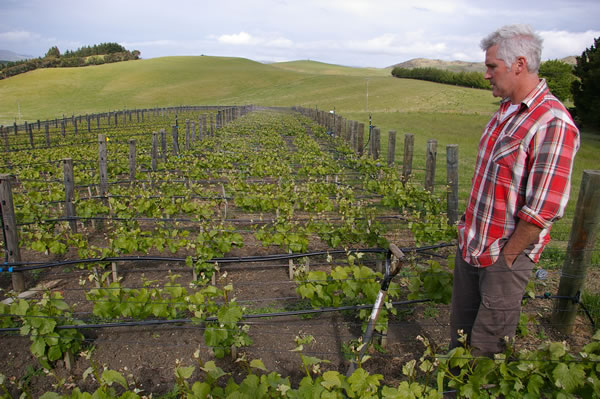
After a protracted search period, Mike and Claudia
discovered their dream site, in the Pyramid Valley, near Waikari in
North Canterbury, in 2000. The hills around here have quite a bit
of limestone, but limestone alone isn’t what Mike was looking
for. He was after the soil of the great vineyards of Burgundy,
which consist of a layer of clay merging into with limestone. The
limestone gives structure to Pinot Noir, while the clay gives
flesh. Too much limestone, and the vines encounter problems with
chlorosis (iron deficiency, resulting in pale yellow leaves). 'The
French call this clay-lime complex "argilo-calcaire"',
says Mike, 'and their simple observation (made over something like
1200 years) is that Pinot Noir and Chardonnay, to be at their
best, require the mix - neither only clay nor only lime at the
surface, but a marriage of the two.' He says that the bedrock
isn't so important, although fractured limestone or chalk are
perfect, because they release excess moisture, but retain
sufficient water for the vine to drink evenly, without
irrigation, throughout the growing season.
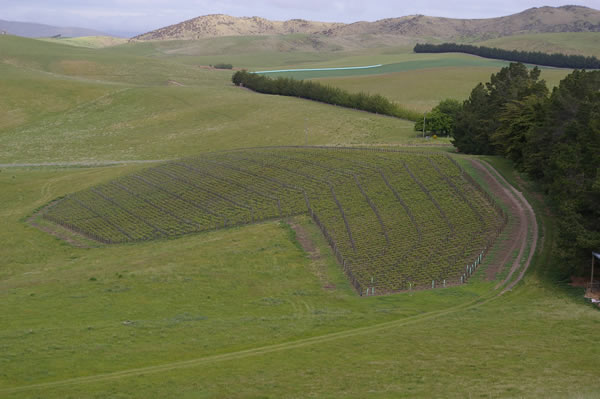
On
their property, they have planted four small vineyards at a high
density of 10-12 000 vines per hectare. These are remarkable: the
vines are packed in, in narrow rows, with single guyot training at
about a foot off the ground. These vineyards, known collectively
as the ‘home vineyards’ are planted with Pinot Noir and
Chardonnay, and are known by the colloquial names of the
predominant weed species in each.
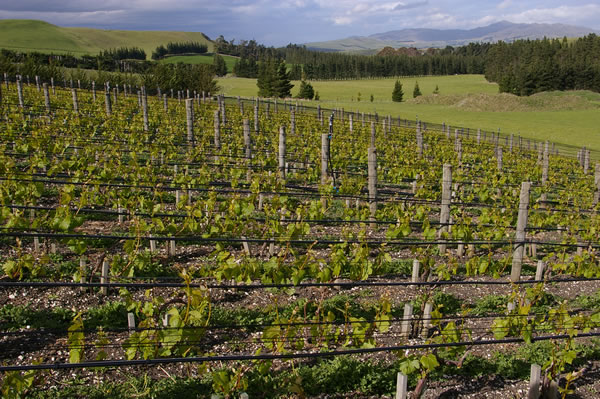
There’s
the ‘Earth Smoke’ Pinot Noir vineyard, which is named after
fumitory; ‘Angel Flower’ Pinot Noir vineyard named after
yarrow (the basis of biodynamic preparation 502); ‘Lion's
Tooth’ Chardonnay vineyard, named after dandelion (from the
French dent de lion;
used in biodynamic preparation 506); and the ‘Field of Fire’
Chardonnay vineyard named after a grass called twitch or quack.
The boundaries of these vineyards are irregular, respecting the
nature of the variation in the soils underneath them. There’s a
deep integrity to the Weersing’s approach here.
As
well as being passionate about terroir, the Weersings are
committed to biodynamics, and from the outset their vineyards have
been managed biodynamically – and for the first two years,
totally by hand, without the help of tractors. While they have
been waiting for the home vineyards to come into production, they
have begun with a range of wines from other vineyards, called the
Growers Collection.
‘The
idea is to make wines from sites and varieties that interest us,
or styles that people aren’t making’, explains Mike. ‘We go
to a grower and say that we’d like to lease an acre or two. We
pay per acre and then do the work ourselves, just renting some of
the vineyard. We change the spray program, alter the pruning, turn
the irrigation off: it’s great for us to have control over fruit
and great for them because they see another way of doing
things’.
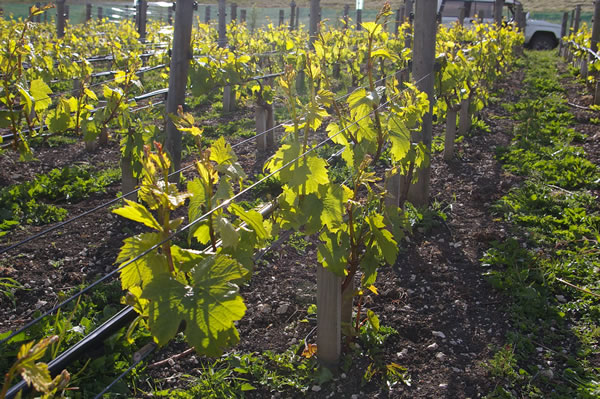
The
wines are made in a commercial facility, so a week before harvest,
Mike takes some grapes, sieves the juice and ferments it. The
ferment is tracked, and once it builds up a good population of
yeasts, Mike uses it as a pied
de cuve, introducing to the freshly harvested grapes a large
population of healthy yeast. Mike reports that each vineyard pied
de cuve looks different, like a meadow with lots of different
kinds of yeast. ‘If you do a pied de cuve every year, each year
you have a different population based on that year’, he
explains. ‘You get the yeast population of that season.’ He
adds that, ‘I have a creeping horror of the way people want to
minimize vintage variation: if it isn’t there the wine has been
airbrushed. It might as well be beer or coca cola’.
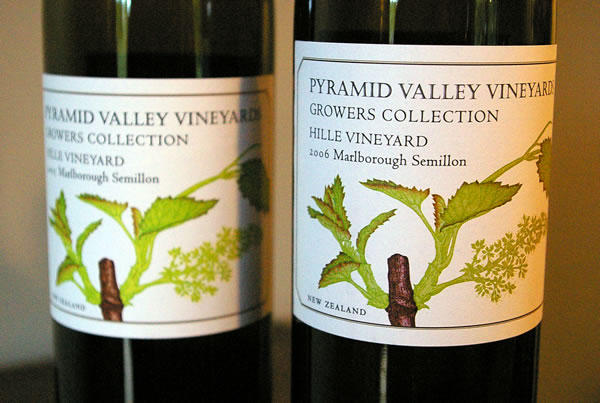
So
what about the wines? I think they are incredibly good. The
Growers Collection wines are all really interesting and I
recommend them all. I tried only samples of the two home block
Pinot Noirs; since my visit the wines have been released: I was
absolutely stunned by the samples I tried.
Pyramid
Valley Vineyards Growers Collection Kerner Estate Pinot Blanc 2006
Marlborough
This has a nutty nose with a minerally, bready, appley character.
Quite pure. The palate is fresh with lovely acidity and a pleasing
mealy, broad, bready, fruity notes. Lovely focus and acidity here.
This took 11 months to finish fermenting, which presumably
contributes to its interesting textural characters. 91/100
Pyramid
Valley Vineyards Growers Collection Hille Vineyard Semillon 2006
Marlborough
Amazing green herbal blast on the nose: very pure and fresh
with striking savoury, green herby character. The palate is crisp
and very fresh with lemony fruit and herbiness, as well as high
acidity. ‘I think it will be better in time’, says Mike
Weersing, and I agree. 92/100
Pyramid
Valley Vineyards Growers Collection Hille Vineyard Semillon 2005
Marlborough
Fresh, complex, intense limey nose with a herby edge and some
smoky notes. The palate is complex and full with mouthwateringly
intense herby flavours. Complex and intense, with lovely poise:
this should be close to immortal. Semillon ripens over a long
period, and the key to working with it (according to Mike
Weersing) is managing this ripeness: he has to pick the vineyard a
few times. 94/100
Pyramid
Valley Vineyards Growers Collection Lebecca Vineyard Riesling 2006
Marlborough
Mike Weersing didn’t want to predicate the style of this
wine: he just hand-picked, got a vineyard pied de cuve going and
then the wine stopped itself at Spätlese/Auslese level in 2005,
and Spätlese level in this 2006. Interesting chalky, minerally
nose with some struck match reductive notes and sweet honeyed,
limey fruit. The palate is tangy and fruity with high acidity and
nice sweetness. 90/100
Pyramid
Valley Vineyards Growers Collection Lebecca Vineyard Riesling 2005
Marlborough
Tangy, minerally and grapefruity/limey nose is precise and a
bit smoky. The palate shows lovely ripe fruit and some interesting
minerally, flinty reductive characters. Complex and delicious.
92/100
Pyramid
Valley Vineyards Growers Collection Calvert Vineyard Pinot Noir
2006 Bannockburn, Central Otago
This vineyard, owned by the Calvert family, is shared by
Pyramid Valley, Felton Road (who manage it, biodynamically) and
Craggy Range, all of whom make wines from it. This wine is very
stylish with lovely focus and savoury depth. Bright red and black
cherry fruit nose is vibrantly fruity and nicely poised. The
palate is juicy and fresh with lovely poise and vibrant berry
fruit. There’s some sappy herbiness in the background, as well
as good tannic structure. Intense and fruit dominated. 93/10
Pyramid
Valley Vineyards Growers Collection Eaton Family Vineyard Pinot
Noir 2006 Marlborough
Aromatic, sappy, berry fruit nose that’s typically
Marlborough. The palate shows delicious juicy, vibrant berry fruit
with high acidity and a savoury edge. Fresh and savoury with nice
presence, and just a hint of attractive greenness. 92/100
Pyramid
Valley Vineyards Angelflower Pinot Noir 2006 (sample of final
blend)
The first release from the PVV home block vineyards, with just
30 cases made. Wonderfully aromatic, with deep, sweet red berry
fruits and some spicy depth. Very intense. The palate is bold and
long and pure with a lovely spicy intensity to the savoury fruit.
Lots of tannic structure here: a thrillingly intense, brilliantly
poised wine. 94–96/10
Pyramid
Valley Vineyards Earthsmoke Pinot Noir 2006 (sample of final
blend)
First release, 70 cases made. Fantastic, slightly unusual nose
showing subtle herby notes with a bright cherry character. The
palate shows taut, fresh cherry, red berry and herb notes with
real focus. There’s fantastic elegance here waiting to emerge: I
suspect this will be astonishingly good with focused elegance in a
year or two. This is profound. 94–96/100
Wines tasted 11/07
Find these wines with wine-searcher.com
Back
to top
|

